CFLMT
Your portraiture work seems deeply intimate and emotional. How do you create such a safe and open space for your models during a shoot?
I welcome them into my living room! My priority is the model’s well-being, so I take the time to greet them, understand their energy when they arrive, assess their needs, and let them express themselves without constraints or directives. Listening and kindness are my allies. The shooting environment isn’t neutral; it’s a living space, which creates a relaxed atmosphere. My models don’t pose; we spend time together chatting, testing textures, exploring emotions, and having fun. Photography takes a back seat so the model can feel completely free in a timeless bubble without judgment; photography is a witness to the moment. I reassure them about confidentiality, that at this moment we’re a team, the creative process is shared, which puts us on equal footing and balances power. There’s no right or wrong position or expression since we evolve together; there’s no right or wrong way to do things, there’s our way of creating. They can shout, laugh, sing, cry – everything is okay. I’m hypersensitive, and this helps me perceive feelings and support them throughout the shoot, taking breaks if needed. When we’re done, we take time to discuss the model’s feelings, before and after, and I reassure them about the pictures, even though I don’t show them anything right away because I want them to just enjoy the moment.
You describe your photographic sessions as moments of “letting go.” What does that mean for you, and how do you guide others into that state?
To let go is, for me, the freedom to be oneself without judgment, neither our own judgement nor others’. It’s a state of mind. There are several ways to achieve it. Props are very important; they divert attention and are also tools for expression. They allow a connection with the body and have a playful and regressive side. Awakening the inner child is particularly helpful. A child acts without worrying about others’ gaze, expressing themselves spontaneously. It’s sometimes difficult or painful for some models to let go because they’re in control of their lives and image. Sometimes we don’t achieve it, which is rare but okay. Sometimes they only let go for a few seconds or minutes; I need to be attentive to this. I learn about the intricacies of human functioning every day, and the model learns about themselves; it’s always constructive. We let go when we’re in acceptance of emotions and express them without thinking. I try to open dialogue about the emotional realm; props help connect emotion and expression. It’s not an exact science and will be unique to each person. We’re all different, and it’s important to keep this in mind at the start to avoid specific expectations and follow the energy of the moment, not what we imagined or wished for.
 CFLMT | Au delà | 2023
CFLMT | Au delà | 2023
Why do you choose to leave your photos unretouched? How do your models usually react to seeing themselves in such raw, authentic form?
I aim to help models appreciate and love themselves in their individuality. For this, I feel it’s essential not to retouch their pictures. If they like the photo but it’s retouched, how can they reconcile with an image that isn’t really them? It doesn’t make sense. The authenticity of the photography is proof of their beauty. Actually, I ask them to come as they are in daily life to the session. No special makeup, none at all ideally – as they are every day, and no particular hairstyle. They’ll be as they are on a daily basis; it’s the model being photographed, not a pimped-up or sanitized version.
Models’ reactions vary. They know beforehand that the photos won’t be retouched. They sometimes find it hard to believe it’s really them because they never see themselves like this. Often, they like it, find themselves beautiful. It can be painful at first because the initial look can be very critical, but most often it’s a revelation like “wow, that’s me.” And above all, it reminds them that they allowed themselves to take time for themselves, and it feels good; they dared. They often wonder when the photos were taken because they were in the moment and forgot about the camera for a few instants. And often they tell me afterwards they appreciate that their loved ones say “we really recognize you.” However, when some like it but don’t recognize themselves, they question their own gaze because the photo isn’t retouched, so it is indeed them, and this opens the door to indulgence, self-reflection, and more self-kindness.
How has your training in art therapy influenced your photography process and interactions with the people you photograph?
Concept of well-being photography was there long before the art therapy training. I hadn’t necessarily put precise words to it. It was a tool to help me better welcome and support models, to develop my skills and know-how. It allowed me to improve the method, which continues to evolve. It’s also a way to reassure models; French people tend to love diplomas, it reassures them. I continue to be interested in human nature, psychology, neuroscience, and to train in whatever can help me best support models.
 CFLMT | Eclats de Sand | 2025
CFLMT | Eclats de Sand | 2025
What role does vulnerability play in your portraiture?
For me, vulnerability is showing oneself without artifice and without armor. I think we often confuse vulnerability with weakness, and we are wrong. Showing our vulnerability is also showing our fragilities. I believe it’s in letting go that we’re most fragile but also strongest because it gives us access to our whole self and our instinct, to all our resources. When we connect to our deep nature, it’s also where we shine because we fully express who we are, and it shows. There’s a question of energy, of vibrations that we emit to the world, which makes us beautiful because we’re aligned with who we are and the place we take in this world to form a harmonious whole with what surrounds us.
Do you see photography as a form of healing or self-discovery—for you or for your subjects?
It would be an exaggeration to claim it’s a form of healing. It can be part of the journey. Like any art form, it’s a powerful means of expression that brings out our unconscious. The latter always finds a way to invite itself into photographic work during the shooting, in the choice of models or photos. I prefer it to evacuate cries and tears this way rather than through somatization; in this sense, it’s more a prevention tool than a healing one for me. Photography is a real outlet; I put into it what’s difficult for me to say with words but also what drives and moves me forward. Sharing it with others is a communication ground that’s easy for me. Sharing is one of my values, and it’s a nice way to be in contact with others; if it can lighten someone’s burden or pain even for just a few minutes, then all is for the best.
 CFLMT | Rêveries | 2023
CFLMT | Rêveries | 2023
Your series feels very tactile—glitter, paint, gestures. What inspired this sensory and expressive direction in your visual language?
Sensuality is a way of life for me. Life is made of physical, emotional, and spiritual sensations. To feel is to live. It’s part of me and inevitably, I imagine, of my photographic work. I love to communicate; I need to share, and senses are the means to exchange with others. All senses receive stimuli, and we translate them as positive, negative, neutral, often neutral actually! Fortunately, otherwise we’d be exhausted from a firework of sensations! I think this allows sending a message, which is why I insist that models choose their movement, so it remains natural and true to their way of expressing themselves. The paint and glitter that the model applies themselves allow an inner communication; the model chooses the colors, the quantities of material, which first allows them to express themselves fully and then to get in touch with their own body and awaken their senses, respecting their sensitivity.


Leave a Reply